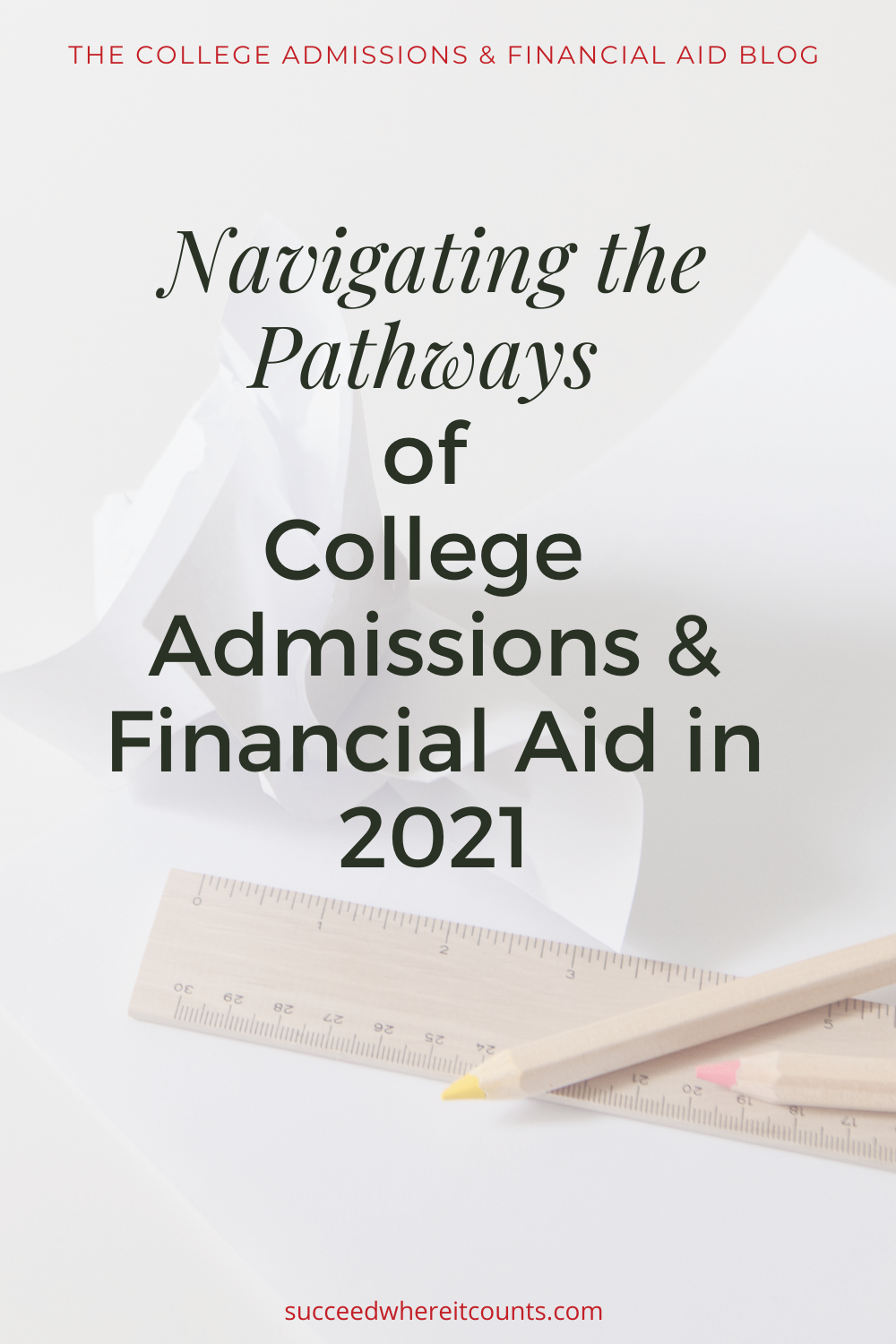January 9, 2021
Pandemic Pandemonium
If you feel that the pathways of college admissions and financial aid are labyrinthine, I would not challenge you about that perception. "Straightforward" is an adjective few veterans of the processes would use.
Merriam-Webster Dictionary defines pandemonium as a chaotic situation (https://www.merriam-webster.com/dictionary/pandemonium). Who could argue with that as apt, standing as we are just inside the doorstep of 2021? Sadly, for us all, the current pandemic is adding confusion to the chaos.
 What were high school students (grades 10 and 11, in particular) doing at this time last year? They were marking their calendars for campus visits. High school seniors were making calculated decisions about at which college to matriculate, from among several letters of acceptance. Campus life was a much more exciting prospect to those seniors than to their parents.
Then March arrived, along with the national, two-week shut-down to flatten the curve. Longest two weeks of my life! How about yours? So many excited first-year students have suffered through "virtual" higher education, and many from their parents' homes. I wonder how many parents now wish their college student was, in fact, away at college?
What will life look like for current high school seniors, come August, 2021? I have no idea; nor do the colleges; nor does anyone I know of, save the Lord God.
Here are my suggestions for 2021:
· High school seniors plan on campus life, somewhat modified by COVID-19 restrictions. However, also develop an at-home contingency plan. That includes re-organizing space in your house to create a dedicated study room. Include purchasing a new laptop computer with software suitable to the demands of college. Ask your college(s) what they recommend; particularly in your proposed major. For example, one of my former students, and now a rising college senior, needed a very sophisticated software program, with correspondingly powerful processors, for her engineering classes this past fall. Her plan to share with classmates was cancelled by the fact that she could not meet with any of them, even though she was living in a university-owned apartment, conveniently off-campus.
· High school juniors double down on your efforts for campus visits. Contact the colleges on your "Top Six" list. Ask about visiting. For campuses offering "virtual tours" only, schedule an appointment for that (or get the dates those are being offered). Write down every question you can think of. You may find yourself online with just one or two others, providing you a valuable opportunity to get some personal attention. Furthermore, be certain you set foot on the college campuses you are seriously considering, even if it is a private, unscheduled and unofficial visit. It is important that you see the campus, walk around the grounds, and visualize yourself there. Does it feel like the right place for you?
· High school sophomores surely, I mean surely(!) by the fall semester of 2023 campus life will have taken some form of predictability. Therefore, rather than concentrating on "Where?", concentrate on "Why?" For what reason are you going to college? To what end? Is a college education essential to your career-plans following high school? Do you know what those career plans look like? Why not? Those questions, and other similar questions, are much more important than where you will fulfill your higher education; at least for now.
One last fact to mention, and that is regarding financial aid. Big, big changes are coming to the financial aid formulae for the college years beginning Fall 2023-Spring 2024. The changes do not favor the middle class.
What were high school students (grades 10 and 11, in particular) doing at this time last year? They were marking their calendars for campus visits. High school seniors were making calculated decisions about at which college to matriculate, from among several letters of acceptance. Campus life was a much more exciting prospect to those seniors than to their parents.
Then March arrived, along with the national, two-week shut-down to flatten the curve. Longest two weeks of my life! How about yours? So many excited first-year students have suffered through "virtual" higher education, and many from their parents' homes. I wonder how many parents now wish their college student was, in fact, away at college?
What will life look like for current high school seniors, come August, 2021? I have no idea; nor do the colleges; nor does anyone I know of, save the Lord God.
Here are my suggestions for 2021:
· High school seniors plan on campus life, somewhat modified by COVID-19 restrictions. However, also develop an at-home contingency plan. That includes re-organizing space in your house to create a dedicated study room. Include purchasing a new laptop computer with software suitable to the demands of college. Ask your college(s) what they recommend; particularly in your proposed major. For example, one of my former students, and now a rising college senior, needed a very sophisticated software program, with correspondingly powerful processors, for her engineering classes this past fall. Her plan to share with classmates was cancelled by the fact that she could not meet with any of them, even though she was living in a university-owned apartment, conveniently off-campus.
· High school juniors double down on your efforts for campus visits. Contact the colleges on your "Top Six" list. Ask about visiting. For campuses offering "virtual tours" only, schedule an appointment for that (or get the dates those are being offered). Write down every question you can think of. You may find yourself online with just one or two others, providing you a valuable opportunity to get some personal attention. Furthermore, be certain you set foot on the college campuses you are seriously considering, even if it is a private, unscheduled and unofficial visit. It is important that you see the campus, walk around the grounds, and visualize yourself there. Does it feel like the right place for you?
· High school sophomores surely, I mean surely(!) by the fall semester of 2023 campus life will have taken some form of predictability. Therefore, rather than concentrating on "Where?", concentrate on "Why?" For what reason are you going to college? To what end? Is a college education essential to your career-plans following high school? Do you know what those career plans look like? Why not? Those questions, and other similar questions, are much more important than where you will fulfill your higher education; at least for now.
One last fact to mention, and that is regarding financial aid. Big, big changes are coming to the financial aid formulae for the college years beginning Fall 2023-Spring 2024. The changes do not favor the middle class.

Succeed Where It Counts
Succeed Where It Counts
Posted in College Planning, College Planning Strategies. Tagged as #collegeplanning, campus life in 2021, college admissions in 2021, Financial Aid, financial aid in 2021, Financial planning.
December 21, 2020
You are at, or about to begin the winter break that coincides with Christmas and Hanukkah. For most of you there are (+/-) fourteen days in which to do as you please. It might please you, if you're a tenth-grader intending to go to college, to write out your plan for college selection, and to set that plan in motion.
In my book, College is a Consumer Purchase (available here), are listed the most common mistakes people make regarding college admissions and financial aid. Among those mistakes is they wait too long to start.
This article is intended specifically for students in the middle of their tenth grade year. A common perception is there is plenty of time before you have to start thinking about college.
Reality check! Twenty to twenty-four short months from now you will be receiving letters of acceptance (or not ugh!).

Two years when you say it that way it sounds like a long time. Twenty-four months? Not so much. Think about everything else you are packing into those two dozen, thirty-day windows of opportunity. There are (at least) eighteen months of school, with homework. There are family vacations, sports games or dance, and similar activities. There are parties to attend, friends to hang-out with you get the picture, right?
Here is a suggested outline of what your plan might look like:
-
December, 2020 complete a professional career assessment. We use the Birkman Profile, administered by LEAProgram, Cincinnati, OH (www.leaprogram.com). It is worth every dollar.
-
January & February 2021 study and assimilate your Birkman report. Begin exploring the career suggestions, hyperlinked in the document.
-
March & April, 2021 continue to explore career options, and also identify college majors that would logically prepare you for those career tracks. For example, what major would you choose to prepare you to become an optometrist?
-
May & June, 2021 begin identifying colleges that are strong in majors you are considering. Universities, in particular, offer a broad array of majors. They do not support those departments equally, however. For example, a university that graduates 500 business majors is going to direct more resources that way, than to its social sciences department that graduates 20 per year.
-
July & August, 2021 Delve more deeply into colleges that look attractive. Contact them. Learn what are their key considerations for admissions.
-
September & October, 2021 Which entrance test will you take SAT or ACT? Do the colleges on your list have a preference? Ask. What is the score on either of those tests that will put you in the top 25% of applicants.
-
November & December, 2021 You are a year into now, and you are beginning to get a clear picture of why you are going to college (that is, what you will do with that education and diploma). You should also have a family conversation about what you can afford by what of annual, out-of-pocket costs.
-
January & February, 2022 Enroll in an SAT/ACT preparation class. That will consume most of the extra time you have for six to eight weeks.
-
March & April, 2022 You will sit for your SAT/ACT exam. Phew! Got that done. You also will continue (or begin) in-person, campus visits. A clear picture of your future

Posted in College Planning, College Planning Strategies. Tagged as #collegeplanning, #collegeplanningtimeline, #tenthgrade.
December 7, 2020
Why do colleges send "Spring Semester Acceptance" letters?
Are you familiar with the phrase "hedging your bets"? It describes a strategy whereby you reduce your risk of loss. You bet on more than one winning option, and reduce your chance of total loss.

By offering some students Spring semester, rather than Fall semester admission, colleges are hedging their bets.
-
Colleges seek to fill every seat in the new, first-year cohort. Some of those students, a few, will drop-out, flunk-out, die (horrible thought); for whatever reason, create vacancies for the Spring semester. Colleges are not guessing, but rather forecasting based on decades of records.
-
A Fall semester drop-out represents a loss of revenue in the Spring. A Spring admit solves that problem.
-
Stats every college keeps them; and every college has to report them. The statistics in focus for this discussion are retention rates and graduation rates.
-
Both datum are required to be kept only on first year, Fall admits. Therefore, transfer students and Spring admits are not considered.
-
Spring admits are students who, by the college's reckoning, are less-well qualified academically and, therefore, more likely to leave the school short of graduation.
Your student has received a Letter of Acceptance, but for the Spring and not the expected, Fall semester. What does that mean?
-
Your student is considered marginally qualified as a scholar for the college's academic rigor. In plain English, the college thinks they may be too hard for your kid. If you have other acceptance letters for the upcoming Fall semester, those options should be strongly considered.
-
Your student will receive little or no financial aid, beyond what the family qualifies for based on financial need. The "scholarships" will have been given out to the Fall class. Even some federal dollars may be in short supply until the following Fall semester. That may be made up with financial aid in the form of loans (not really aid, but considered aid in the game of higher education).
-
Most important, in this author's opinion, is the dilemma of what your student will do from June until the end of January. Students enrolling in a community college should check with the four-year school as to how those credits will be handled. Will your child now become a transfer student? Historically, that further impacts financial aid offered. Work? A great option, especially if your students saves most of the money for college expenses.
-
Finally, and related to that last fact of what to do with the time, it is highly likely your student will not find the transition to be smooth. There are so many things shaping a student's experience of Fall semester admissions that simply cannot be replicated for the Spring admit. I am not speculating, but rather relating the experience of the few students I know who went ahead with a Spring semester matriculation.
Bottom line: decline Spring admission. Your child has better options.
Want to know the top 5 mistakes to avoid when sending your student to college? Be sure to grab your copy of our free download by clicking the button below!

Succeed Where It Counts
Succeed Where It Counts
Posted in College Planning, College Planning Strategies. Tagged as #applyingforcollege, #applyingtocollege, #collegeapplications, #collegeplanning, #financialaid, #howtopayforcollege, #springsemesteracceptance.
November 30, 2020
Why do colleges "Wait List" some students?
The answer is found in the principle that colleges are selling higher education services, and parents are the customers. That means that Letters of Acceptance are issued primarily for the benefit of the colleges. They accept who they want, when they want, how they want.

Colleges track their admissions data very closely, over decades of time. Those large numbers give them a very accurate picture of how many letters of acceptance are needed in order to fill every seat available. Remember, each seat in a first-year cohort is worth hundreds of thousands of dollars over the course of the student's education.
In the administrative offices, "yield" is the number of students who actually matriculate from among the greater number to whom letters of acceptance were sent. Let's take some easy numbers to help your understanding.
Big Time College plans for a first-year class of 2,000. Their historic yield is 50%. Therefore, they sent out 4,000 letters of acceptance, and notify another 1,000 they are on the Wait List. Suppose this year they miss their yield by 1%; 20 students. Big Time College's wait list is now accessed. Starting at the top, they go down the list until they find the 20 students who will accept an offer of admission.
What is the top? The wait listed students are ranked academically from most-well-qualified to less-well-qualified. Those at the top of the list probably missed by inches a letter of acceptance in the first place.
Should you wait on the wait list? Probably not.
-
You will never know how close to the top you are.
-
You will not find out if you are chosen until the deadline for commitment has passed for the other colleges that accepted you.
-
Financial aid will be little or none, because whatever aid they had to give, was committed to those who were accepted in the first round, and who sent in their deposit of commitment.

Posted in College Planning, College Planning Strategies. Tagged as #collegeplanning, #collegewaitlist, #financialaid, #howtohandlecollegewaitlist, #waitlist.
November 9, 2020
Is there a scholarship awarded with your Letter of Acceptance?
Students who submitted college applications weeks ago are receiving Letters of Acceptance already. Those affirmations make everyone happy. Congratulations!

It is not uncommon, not at all, for a scholarship to be awarded along with the acceptance letter. That is also a good thing and, again, congrats.
What is it not, however?
-
It is not truly a scholarship as much as it is a discount off of the price. In other words, no money will ever exchange hands. The college is just offering to charge you less.
-
It is possible the scholarship is for only the first year; not renewable for years two, three and four. Be sure to ask.
-
It is contingent. Contingencies include your senior year of high school grades, your personal deportment both in school and in your community (i.e. don't get busted for doing something stupid) and whether you commit by any deadlines mentioned in the letter.
-
Finally, and most important, it is not the final and formal offer of financial aid. That will come, typically, in late March/early April.
What is that scholarship then?
An enticement to commit before you hear from any other colleges.
Therefore, wait. Wait until at least the end of 2020. By then you will likely have heard from every college to which you applied. If, by then, there are schools from which you have no formal letter of acceptance (or denial of admission) call the school(s) and check on the status of your application.
That last thing reminds me to remind you to check NOW with every college on your list. Make certain they have every requirement in hand. Don't wait. Deadlines are hard stops in college admissions.
Next time let's talk about Wait List and Spring Admission.

Posted in College Planning, College Planning Strategies. Tagged as #collegeplanning, #collegescholarships, #financialaid, #financialaidoffer, #howtopayforcollege, collegeacceptanceletter, scholarshipsforcollege.
October 20, 2020
Is Community College a good option after high school?
You're going to hate me for this answer, but it is, in fact, "Yes and no."

YES:
- For students who are borderline academically qualified for college-level academics. The academic rigor of college is harder than of high school. Most four-year colleges demand more academically than most community colleges.
- For students who desire expressly to earn a technical certification and enter the job market from there. No one should consider that choice as lesser than attending a four-year college. It is simply a different choice. Every adult knows, once in the work force, job performance determines career advancement.
NO:
- For families who think it will save them money. If any money is saved, and that is a proposition easily challenged from the data, the amount saved is modest compared to what is missed.
- For students who think a community college will help them figure out what they want to major in, and what career they want to pursue (with the exception of a technical certification, as mentioned).
The original question (Is community college a good option?) reveals an underlying issue that parents and students should address. Why go to college?
- To find direction for life as an adult? At $25,000 per year (or more) those are expensive directions. Instead, consider getting a job and learning what it takes to earn $25,000 in a year. Enlist for military service and be trained in a career-quality skill, mature as a young adult and, upon completion of active duty feel a sense of accomplishment.
- Because that's what others are doing? That is seldom, if ever, a good reason for doing anything. To reiterate, get a job instead. Find out how hard your parents work to provide for your family. Save most of the money for college. Pay taxes. That's an education, too.
Succeed Where It Counts
Succeed Where It Counts
Posted in College Planning, College Planning Strategies. Tagged as #collegeplanning, #collegeplanninglkn, #communitycollege, #howtopayforcollege, #payingforcollege.








 Subscribe
Subscribe
